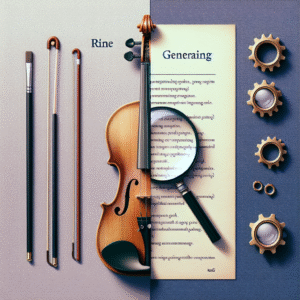Mastering Distillation for Smaller Models: Essential Tips for Immediate Implementation
Table of Contents
- 1. Introduction
- 2. Understanding Distillation
- 3. Why Distill Smaller Models?
- 4. Essential Tips for Distillation
- 4.1 Choose the Right Teacher Model
- 4.2 Data Preparation is Key
- 4.3 Adjusting Loss Functions
- 4.4 Temperature Scaling
- 4.5 Implementing Regularization Techniques
- 5. Real-World Applications
- 6. Challenges and Solutions
- 7. Case Studies
- 8. The Future of Distillation
- 9. Conclusion
1. Introduction
In the fast-paced world of machine learning and AI, finding ways to be efficient is key. As models get bigger and more complex, figuring out how to deploy them where resources are tight becomes a real challenge. This is where model distillation steps in—think of it as a way to shrink down those hefty models into leaner, quicker versions without losing out on performance.
Model distillation is a bit like summarizing a long book; you take a detailed, complex model (the teacher) and distill its knowledge into a more manageable version (the student). This technique is particularly handy for smaller models designed to run well on limited computational power. Whether you’re building mobile apps, working with edge devices, or just trying to make the most out of cloud resources, distillation is your ticket to unleashing the potential of those smaller models.
In this post, we’ll walk through some essential tips to get started with distilling smaller models. We’ll go over the process step by step, share practical insights, and look at real-world applications. By the end, you’ll have a solid grasp of how to leverage this powerful technique right away. Whether you’re a pro data scientist or just dipping your toes into machine learning, this guide has got actionable tips to help you enhance your models through distillation.
2. Understanding Distillation
So, what exactly is model distillation? It’s all about training a smaller model to mimic the behavior of a larger, more complex one. This approach emerged from the need to deploy machine learning models in settings where computational power is at a premium, all while maintaining a high level of accuracy.
At its core, distillation transfers knowledge from the teacher model to the student model. Typically, the teacher is a deep neural network with a complex architecture, trained on a dataset to perform a task with great accuracy. Once it’s up to speed, we then train the student model using the outputs (or soft labels) produced by the teacher.
There are some big advantages to this approach:
- Efficiency: Smaller models need less memory and computational power, making them perfect for resource-limited environments.
- Faster Inference: Because they’re lighter, smaller models can handle inputs more quickly, leading to faster responses.
- Reduced Overfitting: Distillation can help lessen overfitting by providing a smoother target distribution for the student model to learn from.
Grasping this fundamental concept of transferring knowledge is essential as we dive into effective strategies for distillation.
3. Why Distill Smaller Models?
So, why bother distilling smaller models in the first place? There are a few practical reasons that make this approach attractive in the world of machine learning.
3.1 Resource Limitations
In many real-world applications—think healthcare, finance, and mobile tech—computational resources can be pretty tight. With distillation, we can create smaller models that still perform well, ensuring that predictions can be generated without needing a supercomputer.
3.2 Deployment Scenarios
For applications that require quick responses, like self-driving cars or real-time fraud detection, deploying smaller models is absolutely crucial. Distilled models deliver the speed we need without cutting corners on accuracy.
3.3 Scalability
As companies grow their machine learning efforts, the demand for efficient models skyrockets. Distillation allows for the quick deployment of multiple small models, each tailored for specific tasks, boosting overall efficiency.
4. Essential Tips for Distillation
To effectively implement distillation, you’ll want to keep some key strategies in mind. Here are some essential tips to help you successfully distill smaller models.
4.1 Choose the Right Teacher Model
The first step is picking the right teacher model. You want a model that’s complex enough to capture the nuances of your task while still performing well with your dataset.
Here are a few things to think about when selecting your teacher model:
- Performance: Make sure your teacher model achieves high accuracy on the validation set, so the distilled version can inherit this capability.
- Architecture: Choose a model architecture that’s known to excel with your specific data type, whether it’s images, text, or structured data.
- Training Time: Balance the performance of the teacher model with how long it takes to train. A model that takes forever to train might not fit your timeline.
4.2 Data Preparation is Key
Data quality is everything in machine learning, and distillation is no exception. The data you use to train both the teacher and student models should be curated and preprocessed carefully to achieve the best results.
Here are some important factors to consider:
- Data Augmentation: Use techniques to boost the variability of your training data. This can help the student model learn more robust representations.
- Labeling Quality: Make sure your training dataset labels are accurate and truly reflect the underlying distributions.
- Balanced Dataset: Aim for a balanced dataset that represents all classes equally to avoid any bias in the student model.
4.3 Adjusting Loss Functions
Choosing the right loss function is a big part of successful model training. For distillation, you’ll need to tweak the loss function so that the student model learns effectively from the teacher model.
Think about using a mix of losses:
- Cross-Entropy Loss: Great for classification tasks, this should definitely be part of your loss function when training the student model.
- Kullback-Leibler Divergence: This function measures how one probability distribution diverges from a second expected distribution. It’s especially useful in distillation to see how closely the student model mimics the teacher’s soft targets.
- Combined Loss: Consider a combined loss that includes both the cross-entropy loss with hard labels and Kullback-Leibler divergence with soft labels to provide a balanced learning signal.
4.4 Temperature Scaling
Temperature scaling is a technique used in distillation to control how smooth the output probabilities are from the teacher model. By tweaking the temperature of the softmax function, you can influence how the student model learns from the teacher.
Here’s the gist:
- Higher Temperature: Raising the temperature gives you softer probabilities, letting the student learn from the teacher’s less confident predictions.
- Lower Temperature: Lowering the temperature sharpens the probabilities, focusing more on the teacher’s most confident predictions.
Getting the right temperature just right is key and often involves some experimentation.
4.5 Implementing Regularization Techniques
Regularization is crucial for keeping the student model generalizable during the distillation process. Some effective strategies include:
- Dropout: Incorporate dropout layers in the student model to help prevent overfitting by randomly turning off certain neurons during training.
- L2 Regularization: Adding L2 regularization can help penalize large weights, leading to simpler models that perform better overall.
- Early Stopping: Monitor validation performance and stop training when it plateaus to avoid overfitting.
5. Real-World Applications
Model distillation isn’t just theory; it’s been put to use successfully across various industries with impressive results.
5.1 Mobile Applications
In the world of mobile apps, where resources can be scarce, distilled models have proven to be a game changer. For example, Google has used distillation in mobile versions of models like BERT, enabling efficient natural language processing right on smartphones.
5.2 Autonomous Vehicles
When it comes to autonomous vehicles, smaller models can process data from cameras and sensors much faster, which is absolutely vital for making real-time decisions. Distillation makes it possible to deploy effective models that can handle the limited computational power on board.
5.3 Healthcare
In healthcare, distilled models can play a significant role in diagnosing diseases through medical images. For instance, a large convolutional neural network (CNN) can be distilled into a smaller model that still holds up for image classification tasks—perfect for deployment in low-resource settings.
6. Challenges and Solutions
Even with all its advantages, distillation isn’t without its bumps in the road. Practitioners may face some challenges during implementation.
6.1 Model Performance
A common concern is whether the distilled model will perform as well as the teacher model. You can tackle this by fine-tuning hyperparameters and using robust training techniques.
6.2 Training Time
Training times can drag on, especially for larger teacher models. To speed things up, consider using transfer learning, leveraging pre-trained models to cut down on training time.
6.3 Overfitting the Student Model
To combat overfitting, make sure you’re using effective regularization techniques, keeping an eye on validation performance, and implementing early stopping as needed.
7. Case Studies
Looking at specific instances where distillation has been successfully applied can provide some great insights.
7.1 Google’s DistilBERT
Google’s DistilBERT is an excellent example. It’s a smaller version of the BERT model that retains a whopping 97% of its language understanding capabilities while being 60% faster. This was made possible through smart distillation techniques, showcasing the power of model optimization.
7.2 NVIDIA and TensorRT
NVIDIA’s TensorRT framework is another great case. It allows for the efficient deployment of deep learning models, utilizing distillation to create optimized models for real-time inference on GPUs. This has wide-ranging implications for various applications, from gaming to autonomous systems.
8. The Future of Distillation
The future looks bright for model distillation. As machine learning continues to progress, the demand for efficient and accurate models is only going to grow. Researchers are exploring innovative techniques like self-distillation, where a model learns from its own predictions, and multi-teacher distillation, where several teacher models contribute to the student model.
Moreover, advancements in hardware and software optimizations are expected to streamline the distillation process, making it accessible to a wider audience.
9. Conclusion
All in all, model distillation is a vital technique for transforming complex models into smaller, more efficient versions without sacrificing performance. By grasping the process and implementing key strategies—like selecting the right teacher model, preparing your data well, adjusting loss functions, and applying regularization techniques—you can achieve some impressive results.
The applications for distillation are vast, spanning industries from mobile technology to healthcare. As the field continues to evolve, so too will the methods and techniques associated with distillation. If you’re ready to dive in, now’s the perfect time to explore the world of model distillation and unlock the full potential of smaller models.
Excited to get started? Begin your distillation journey today and experience the power of efficient machine learning!






